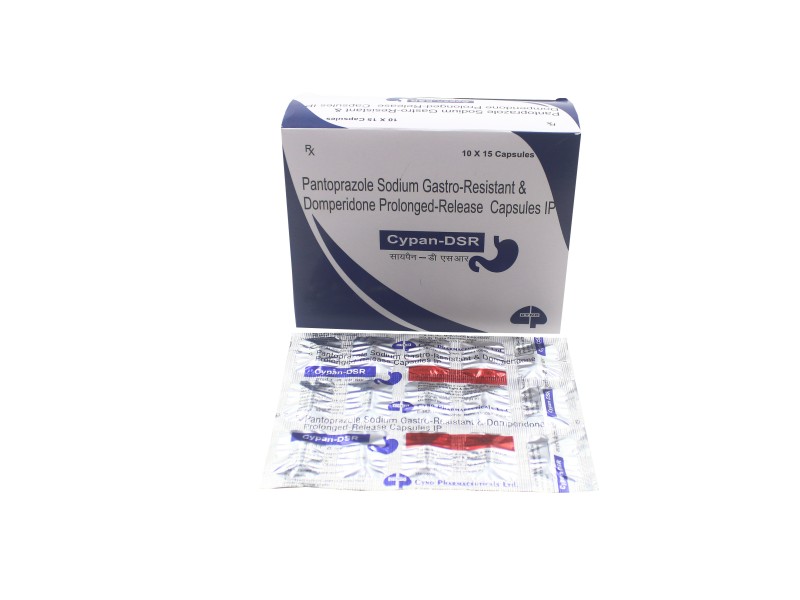Cypan DSR
Pantoprazole sodium (40mg), Domperidone (30mg)
Cypan-DSR Capsule is a prescription medicine used to treat gastroesophageal reflux disease (Acid reflux) and peptic ulcer disease by relieving the symptoms of acidity such as indigestion, heartburn, stomach pain, or irritation.
Pantoprazole reduces the amount of acid produced in your stomach. It is used for heartburn, acid reflux and gastro-oesophageal reflux disease (GORD) – GORD is when you continue to get acid reflux. It is also taken to prevent and treat stomach ulcers.
Domperidone is a dopamine antagonist with anti-emetic properties domperidone does not readily cross the blood-brain barrier. Its anti-emetic effect may be due to a combination of peripheral effects and antagonism of dopamine receptors in the chemoreceptor trigger zone, which lies outside the blood-brain barrier in the area postrema.

Mechanism of action:
- Pantoprazole is a proton pump inhibitor. After administration, it spreads to the parietal cell of the stomach and accumulates in the secretory canal. Pantoprazole is converted to sulphonamide in an acidic medium. This sulphonamide covalently interacts with the sulfhydryl (SH) group in the proton pump (H + K + ATPase) and inhibits the exchange of extracellular K + for intracellular H + ion. Pantoprazole irreversibly inhibits proton pump activity and reduces gastric acid secretion. Pantoprazole is more acid-stable and its activity is lower at higher ph. It is the only proton pump inhibitor available in parenteral form.
Pharmacokinetics:
- Absorption: Pantoprazole is well absorbed after oral administration. Its bioavailability is about 77% as it first undergoes metabolism.
- Distribution: It is widely distributed in the body in protein-bound form.
- Metabolism: Pantoprazole is extensively metabolized in the liver.
- Excretion: It is excreted mainly in urine and small amounts in faeces.
Pharmacodynamics:
- This drug acts to decrease gastric acid secretion, which reduces stomach acidity. Pantoprazole administration leads to long-lasting inhibition of gastric acid secretion.16General EffectsPantoprazole has been shown to reduce acid reflux-related symptoms, heal inflammation of the esophagus, and improve patient quality of life more effectively than histamine-2 receptor antagonists (H2 blockers). This drug has an excellent safety profile and a low incidence of drug interactions. It can be used safely in various high-risk patient populations, including the elderly and those with renal failure or moderate hepatic dysfunction.1Due to their good safety profile and as several PPIs are available over the counter without a prescription, their current use in North America is widespread. Long term use of PPIs such as pantoprazole have been associated with possible adverse effects, however, including increased susceptibility to bacterial infections (including gastrointestinal C. difficile), reduced absorption of micronutrients including iron and B12, and an increased risk of developing hypomagnesemia and hypocalcemia which may contribute to osteoporosis and bone fractures later in life.12
Precautions:
- Hepatic impairment.
- Monitor liver function.
- Avoid prolonged use.
Side effects:
Headache, Diarrhoea, Nausea, Abdominal pain, Vomiting, Flatulence, Dizziness
Arthralgia (joint pain)
Dosage:
- Oral: Adult: 20–40 mg/day before breakfast.
- Duodenal ulcer: 40 mg/day should be taken 2 – 4 weeks before breakfast.
- Benign gastric ulcer: 40 mg/day should be taken before breakfast for 1 – 2 months.
- Zollinger-Ellison syndrome: By increasing the dose to 80 mg/day in 2 divided doses, it can be increased to 240 mg/day if necessary.
- Gastroesophageal reflux disease: 20 – 40 mg/day should be taken for 1 month before breakfast and if necessary, continue treatment for 1 more month.
- Parenteral: 40 mg as an IV injection once in 15 minutes.
- Children under 12 years old: Not recommended.
Over dosage:
- Give supportive measures and symptomatic treatment.
Warning:
- People taking high, multiple daily doses for more than a year have an increased risk of bone fractures.
- Vitamin B-12 deficiency, which can cause severe nerve damage and worsening of brain functions.
- Chronic inflammation of the stomach’s lining (atrophic gastritis) when taking pantoprazole for a long term. People with H. pylori are particularly at risk.
- Low blood magnesium (hypomagnesemia), has been seen in some people taking pantoprazole for up to three months. More often, it occurs after one year or more of treatment.
Duration of action:
- Avanafil has a plasma half-life (T1 / 2) of 3–5 hours and a maximum duration of action of 6 hours.
Drug- drug interactions:
- There are no clinically relevant interactions at therapeutic doses-
Phenazone: diazepam, digoxin, theophylline, carbamazepine, diclofenac, phenytoin, warfarin, nifedipine, caffeine, metoprolol, or ethanol.
Oral contraceptives: hormonal contraceptive does not appear to compromise efficacy as no interactions with low-dose combined oral contraceptives have been observed.
Adverse reactions:
1. Diarrhoea 2. Nausea 3. Vomiting 4. Headache 5. Flatulence 6. Abdominal pain 7. Pruritis 8. Dizziness 9. Rash.
Pregnancy:
- Contraindicated
Fertility:
- There was no evidence of impaired fertility.
Contraindications:
- Hypersensitivity to Pantoprazole
Storage:
- Store at 15 – 30 degree C in a tightly closed container.
- Protect from light.
Breastfeeding:
- Contraindicated
